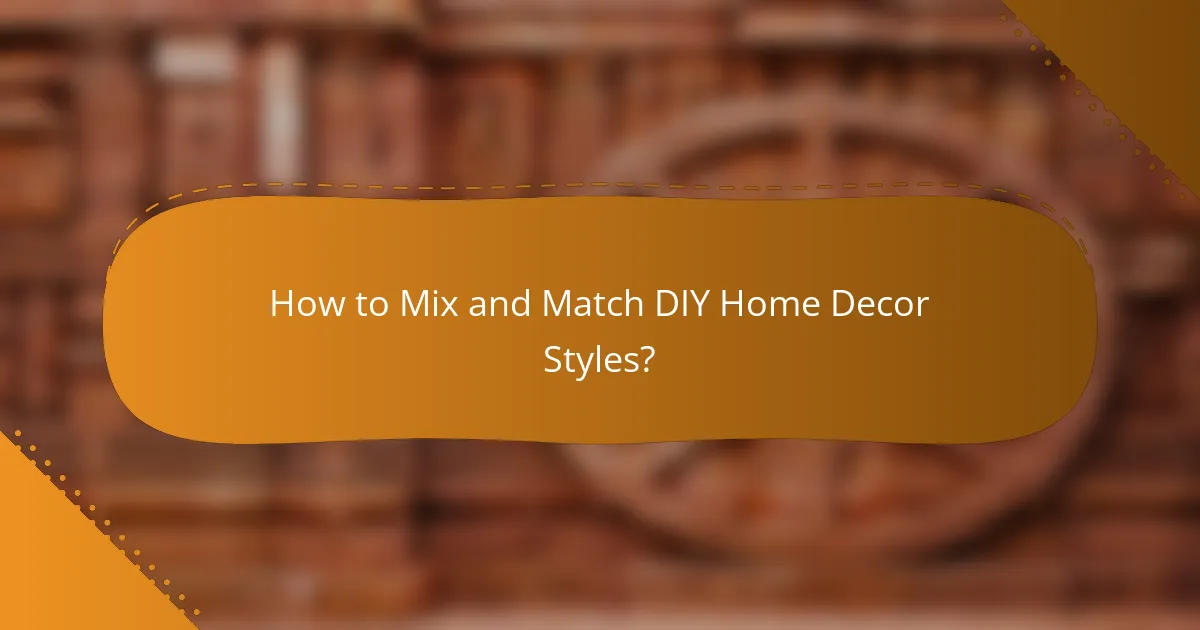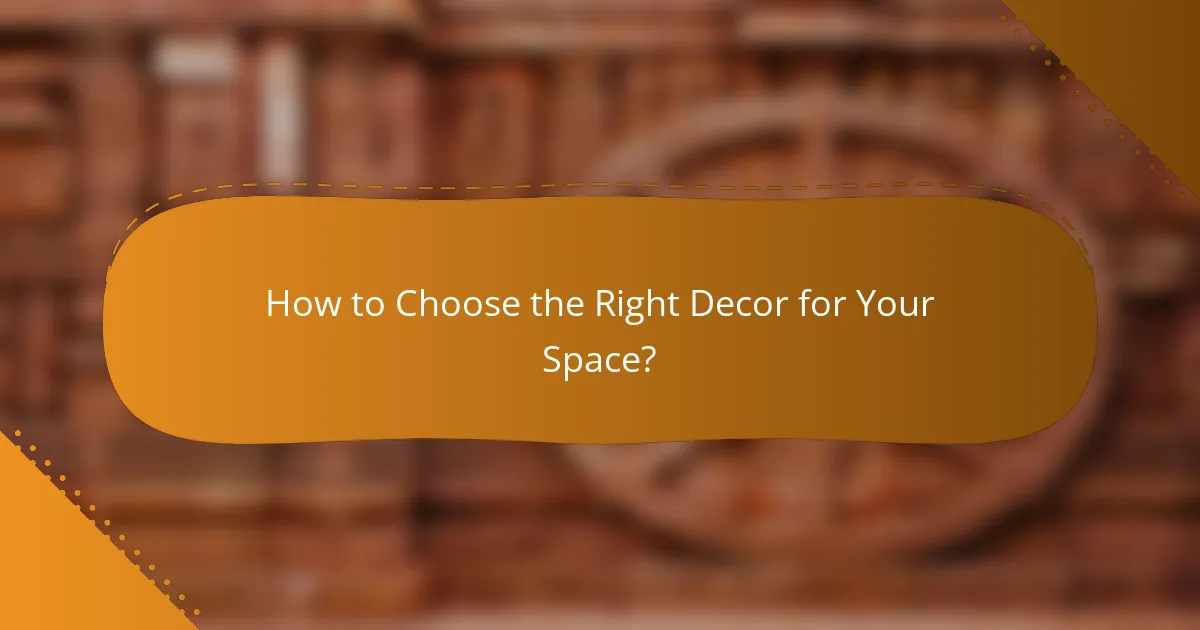Mixing and matching DIY home decor styles allows you to create a unique and personalized space that reflects your individual taste. By focusing on complementary color palettes, textures, and key furniture pieces, you can blend various aesthetics to achieve a cohesive look. Infusing personal elements, such as artworks and heirlooms, further enhances your decor, making your home truly one-of-a-kind.

How to Mix and Match DIY Home Decor Styles?
Mixing and matching DIY home decor styles involves combining different aesthetics to create a unique and personalized space. To achieve this, focus on color palettes, textures, and key furniture pieces that complement each other while reflecting your personal taste.
Eclectic Style Combinations
Eclectic style is all about embracing diversity and creativity. To successfully mix various decor styles, choose a unifying element, such as a color scheme or a specific material, that ties the different pieces together. For instance, pairing vintage furniture with contemporary art can create a striking contrast that feels cohesive.
When combining styles, consider the scale and proportion of your items. Large, bold pieces can dominate a space, while smaller accents can provide balance. Aim for a mix of textures, such as soft fabrics with hard surfaces, to add depth to your design.
Modern and Rustic Fusion
Combining modern and rustic styles creates a warm yet sophisticated atmosphere. Start with a neutral color palette, incorporating natural materials like wood and stone alongside sleek metal and glass elements. This blend can be achieved through furniture choices, such as a reclaimed wood dining table paired with modern metal chairs.
To enhance this fusion, focus on lighting. Industrial-style fixtures can complement rustic elements, while minimalist designs can keep the space feeling open and airy. Avoid overcrowding the area; instead, select a few statement pieces that represent both styles.
Bohemian and Minimalist Blend
The bohemian and minimalist blend emphasizes simplicity while allowing for personal expression. Start with a minimalist foundation, using neutral colors and clean lines, then introduce bohemian elements like patterned textiles, plants, and unique art pieces. This approach allows for a curated yet relaxed vibe.
When mixing these styles, be mindful of clutter. Select a few standout bohemian items that resonate with you, and let them shine against the minimalist backdrop. This balance creates a harmonious space that feels both inviting and uncluttered.

What are Popular DIY Home Decor Styles?
Popular DIY home decor styles include a variety of aesthetics that allow individuals to personalize their living spaces. Each style has unique characteristics and elements that can be mixed and matched to create a cohesive look that reflects personal taste.
Scandinavian Design
Scandinavian design is known for its minimalism, functionality, and connection to nature. This style often features a neutral color palette, natural materials, and clean lines, creating a serene and uncluttered environment.
To achieve a Scandinavian look, focus on incorporating light woods, soft textiles, and simple furniture. Consider adding plants for a touch of greenery, and use layered lighting to enhance the cozy atmosphere.
Industrial Aesthetic
The industrial aesthetic draws inspiration from warehouses and factories, characterized by raw materials and a utilitarian feel. Common elements include exposed brick, metal fixtures, and reclaimed wood, which contribute to a rugged yet stylish ambiance.
When embracing this style, aim for open spaces with high ceilings and large windows. Use furniture that combines metal and wood, and consider incorporating vintage items to add character. Keep in mind that balance is key; avoid overcrowding the space with too many items.
Farmhouse Chic
Farmhouse chic blends rustic charm with modern sensibilities, creating a warm and inviting atmosphere. This style often features distressed wood, vintage decor, and soft, neutral colors, making it perfect for creating a cozy home.
To achieve farmhouse chic, focus on layering textures with throw pillows, blankets, and rugs. Incorporate vintage finds like mason jars or antique furniture, and use open shelving to display decorative items. Remember to keep the space functional while maintaining a relaxed vibe.

How to Personalize Your Home Decor Aesthetic?
Personalizing your home decor aesthetic involves infusing your unique style and preferences into your living space. This can be achieved by incorporating personal artworks, using family heirlooms, and creating custom color palettes that reflect your individuality.
Incorporating Personal Artworks
Personal artworks can significantly enhance your home decor by adding character and a sense of belonging. Consider displaying paintings, photographs, or sculptures that resonate with you or represent meaningful experiences.
When selecting artworks, think about the themes and colors that align with your overall decor. A cohesive look can be achieved by grouping pieces with similar styles or color schemes, creating a gallery wall that tells your story.
Using Family Heirlooms
Family heirlooms bring a rich history and emotional connection to your home decor. Items like antique furniture, vintage textiles, or cherished collectibles can serve as focal points or accents in your space.
To effectively incorporate heirlooms, consider their scale and style in relation to your existing decor. Mixing modern elements with traditional pieces can create a balanced aesthetic, but be mindful of maintaining harmony to avoid visual clutter.
Custom Color Palettes
Creating a custom color palette allows you to tailor your home decor to your personal taste. Start by selecting a few base colors that evoke the mood you want in your space, then choose complementary shades to enhance the overall look.
Use tools like color swatches or online design apps to visualize how different colors work together. Aim for a palette that includes a mix of neutrals and accent colors, ensuring versatility across various rooms while maintaining a cohesive feel throughout your home.

What Tools are Essential for DIY Home Decor?
Essential tools for DIY home decor include a variety of hand tools, painting supplies, and decorative accessories. These items help you effectively create and personalize your space while ensuring quality results.
Basic Hand Tools
Basic hand tools are fundamental for any DIY project. Key items include a hammer, screwdrivers, pliers, a measuring tape, and a utility knife. These tools allow you to assemble furniture, hang decor, and make precise cuts.
When selecting hand tools, consider investing in quality brands that offer durability. A good set of tools can range from $50 to $200, depending on the number of pieces and brand reputation.
Painting Supplies
Painting supplies are crucial for refreshing walls and furniture. Essential items include paintbrushes, rollers, painter’s tape, drop cloths, and paint trays. Choose high-quality paint for better coverage and durability.
For a typical room, you might need around one to two gallons of paint, costing between $30 and $70 each, depending on the brand and finish. Always test a small area first to ensure the color meets your expectations.
Decorative Accessories
Decorative accessories enhance the aesthetic of your space. Items like throw pillows, wall art, and decorative vases can personalize your decor style. Consider mixing textures and colors to create visual interest.
When selecting accessories, aim for a cohesive look by choosing items that complement your main color palette. Budget around $100 to $300 for a well-rounded selection of decorative pieces, depending on your style and preferences.

How to Choose the Right Decor for Your Space?
Choosing the right decor for your space involves understanding the room’s purpose, the scale of furniture, and the lighting conditions. By assessing these factors, you can create a cohesive and personalized aesthetic that enhances both functionality and style.
Assessing Room Functionality
Start by determining the primary function of each room. For example, a living room may need comfortable seating for socializing, while a home office requires a productive workspace. Consider how you use the space daily and what activities take place there.
Once you identify the room’s purpose, select decor that complements these activities. For instance, choose durable materials for high-traffic areas and softer textures for relaxation spaces. This alignment ensures that your decor not only looks good but also serves its intended function effectively.
Understanding Scale and Proportion
Scale and proportion are crucial in creating a balanced decor scheme. Measure your space and choose furniture that fits well without overwhelming the room. For example, a large sectional sofa may dominate a small living area, while a petite chair might get lost in a spacious room.
As a rule of thumb, aim for a mix of sizes to create visual interest. Pair larger pieces with smaller accents, and maintain a consistent height across furniture to promote harmony. This approach helps maintain a cohesive look while maximizing comfort and usability.
Evaluating Lighting Conditions
Lighting significantly impacts how decor is perceived. Assess both natural and artificial light sources in your space. Rooms with ample sunlight may benefit from lighter colors and airy fabrics, while darker areas might require brighter hues and reflective surfaces to enhance brightness.
Consider layering your lighting with ambient, task, and accent options. Use floor lamps, table lamps, and wall sconces to create a warm atmosphere. Additionally, remember that the right lighting can highlight decor features and create a welcoming environment.

What are the Costs Involved in DIY Home Decor?
The costs involved in DIY home decor can vary widely based on the materials, tools, and personal choices you make. Generally, budgeting for both materials and equipment is essential to ensure your projects stay within financial limits while achieving your desired aesthetic.
Budgeting for Materials
When budgeting for materials, consider the type of decor you want to create. Common materials like paint, wood, fabric, and hardware can range from affordable to premium options. For instance, a gallon of paint may cost between $20 to $60, while wood for furniture projects can range from $3 to $10 per board foot.
It’s wise to create a detailed list of needed materials and research prices at local stores or online. Look for sales, discounts, or bulk purchasing options to save money. Always allocate a little extra in your budget for unexpected expenses, as DIY projects can sometimes require more materials than initially planned.
Cost of Tools and Equipment
The cost of tools and equipment can be a significant part of your DIY home decor budget. Basic tools like a hammer, screwdriver set, and measuring tape can be relatively inexpensive, often totaling around $50 to $100. However, if your projects require power tools, such as a drill or saw, expect to spend anywhere from $100 to $500 depending on the brand and quality.
Consider whether you need to purchase tools or if you can borrow or rent them. Many hardware stores offer tool rental services, which can be a cost-effective way to access high-quality equipment without the full purchase price. Always factor in the long-term value of tools you buy, as they can be used for multiple projects in the future.


